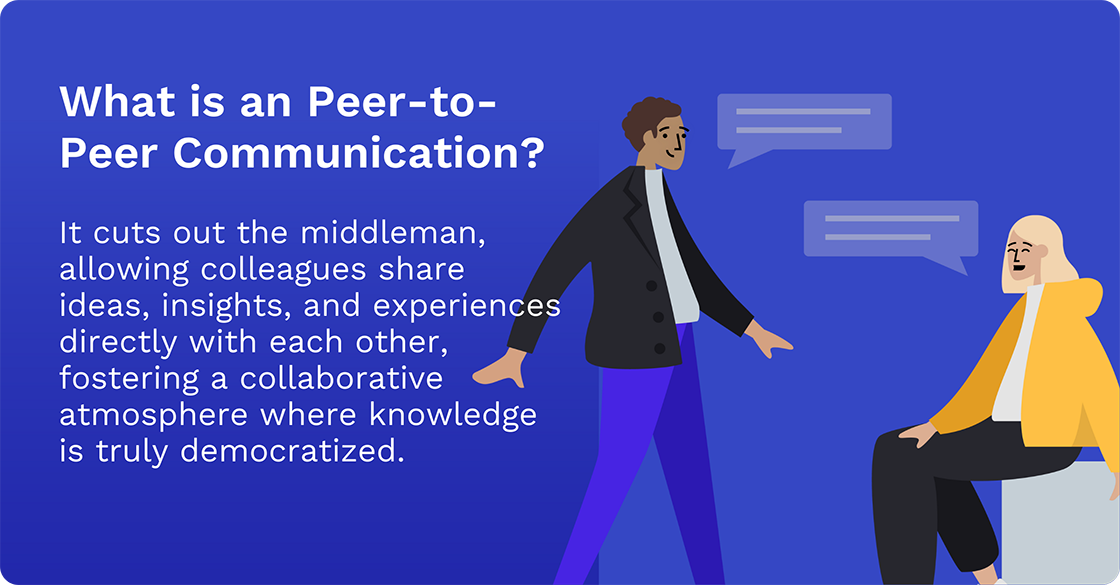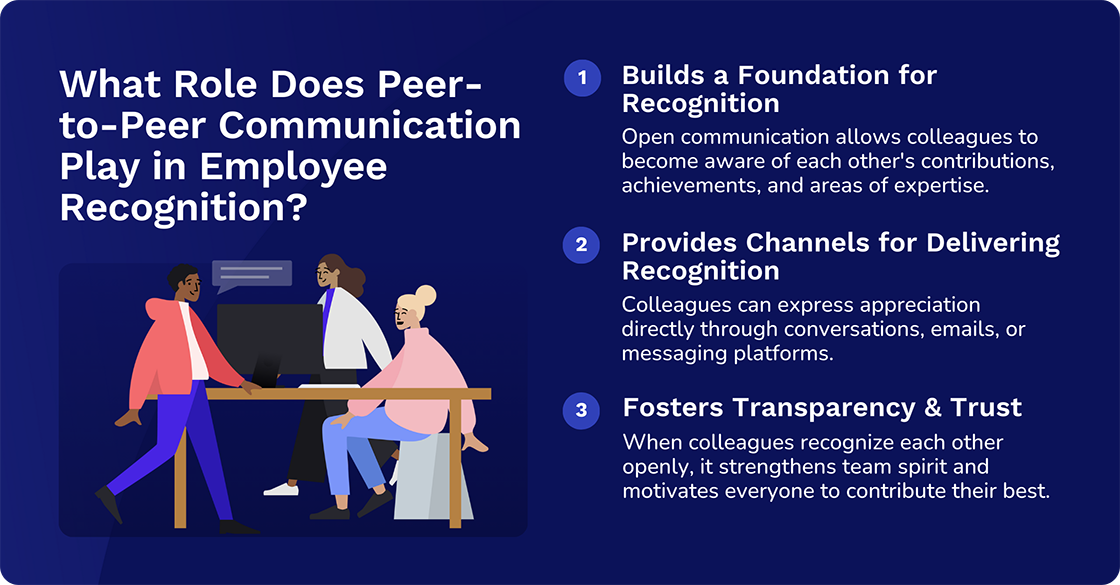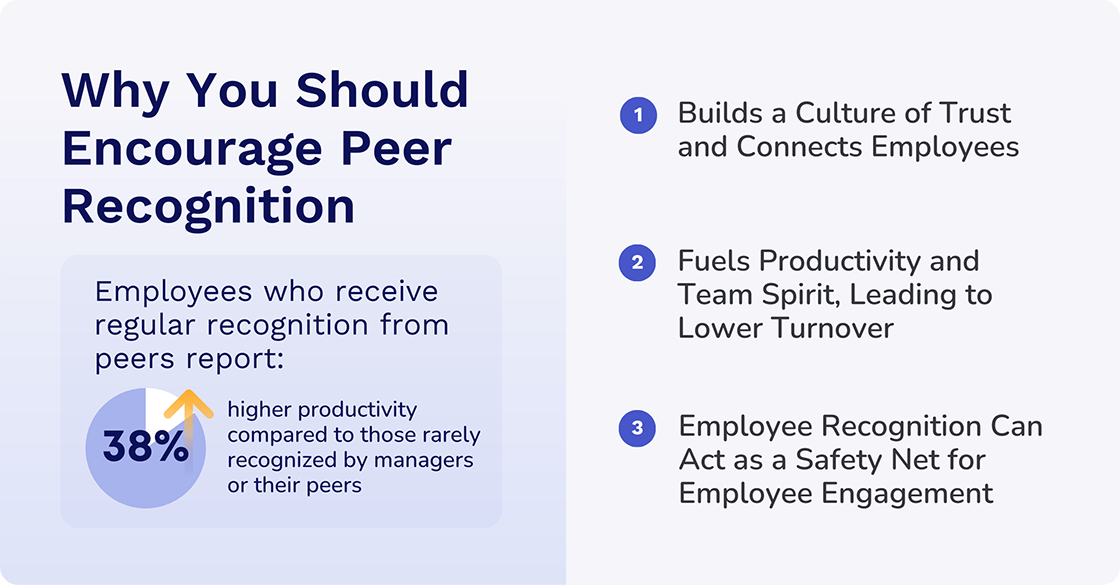Peer-to-peer communication is a vital element of internal communication. We show you how to improve it within your organization to help drive business results.

.webp)
Effective internal communication is the backbone of every successful organization. Learn the ins and outs of internal communications with our research-backed white paper.
Access NowMany people acknowledge that knowledge is power and information is king. But the question is, where does the information come from? While business leadership broadcasts key messages, the truth is that much of the real magic happens in the spaces between colleagues. This is where peer-to-peer communication takes center stage.
This blog post unpacks the power of peer-to-peer communication. It also introduces the concept of peer recognition and shows how it is intertwined with peer-to-peer communication. We explore why peer-to-peer communication and peer recognition are crucial and how they benefit your organization. More importantly, we discuss how you, as an internal communicator, can actively foster and improve vital peer-to-peer communication. From creating a culture of open exchange to utilizing the right tools, we aim to equip you with the knowledge and strategies to unlock the true potential of peer-to-peer communication within your company.
Turn your internal communications strategy around today

Peer-to-peer communication is the same as employee-to-employee communication - the exchange of information and ideas directly between colleagues. It's the quick question you ask your deskmate, the brainstorming session with your project team, or the knowledge sharing that happens over lunch or during breaks.
Peer-to-peer communication cuts out the middleman. Instead of relying on a central server to connect users, devices talk directly to each other. You can think of it as being like two friends whispering secrets. The information is shared quickly and efficiently, without needing to go through a central authority. This is exactly what happens in a healthy work environment. Colleagues share ideas, insights, and experiences directly with each other, fostering a collaborative atmosphere where knowledge is truly democratized.
All types of internal communication are important. Peer-to-peer communication is one type that is absolutely essential for a healthy and productive work environment.

Peer recognition and peer-to-peer communication are closely linked and reinforce each other in the work environment, helping to ensure a positive working relationship between peers.
According to Achievers’ 2023 State of Recognition report, organizations that can successfully increase top-down recognitions will see peer-to-peer recognitions also begin to rise. Their 2024 State of Recognition report confirms that peer recognition continues to drive business results. Furthermore, “HR leaders who say their online platform includes peer recognition are 37% more likely to say their strategies drive business results, compared with organizations without peer recognition.”
Similarly, strong peer-to-peer communication allows colleagues to share information, collaborate effectively, and recognize each other's contributions, leading to a more positive and productive work environment. Here’s the role peer recognition plays:

There are several reasons why peer-to-peer communication is so crucial.
Achievers’ 2024 State of Recognition report provides three key reasons to encourage peer recognition.

While traditional peer-to-peer communication focuses on colleague-to-colleague interactions, internal communicators can also play a key role in fostering this type of communication. Here are some examples of how internal communicators can leverage peer-to-peer communication to build stronger relationships with employees:
According to Achievers’ 2023 State of Recognition report, only 38% of organizations offer peer-to-peer recognition programs. It is, though, one of the most common recognition platforms in the U.S., with 44% of organizations saying it is effective at supporting their objectives. While this is the global average too, these programs aren’t common in all countries, and statistics vary. For instance, in Canada, only 39% say it supports their objective effectively. In the UK, the percentage is 47%, which is higher than the global average.
Turn your internal communications strategy around today

As an internal communicator, you play a crucial role in fostering a culture of strong peer-to-peer communication within your organization. Here are some ways you can go beyond simply encouraging peer-to-peer internal communication and actively contribute to its improvement.

At Cerkl, we understand the importance of providing the right tools to promote effective peer-to-peer communication. Broadcast, our cross-channel employee communications suite, has a mix of invaluable features you can leverage to improve internal communication that will resonate with employees, increasing the bond between peers. They include automated News Digests, a super-efficient mobile app, and SharePoint, a powerful intranet plugin.
By encouraging and facilitating strong employee-to-employee communication, Cerkl can help your organization unlock its full potential. Cerkl Broadcast can help you create a workplace where your colleagues can connect, collaborate, and thrive!
Why is internal communication so important? If you aren’t sure, here’s our The Importance of Internal Communication white paper for you to access free of charge.

Turn your internal communications strategy around today
What does peer-to-peer communication mean? This is the exchange of information and ideas between colleagues who are at a similar level within an organization. It's not a manager giving instructions, but coworkers talking directly to each other.
Why is peer communication important in the workplace? It fosters collaboration, knowledge sharing, and problem-solving. Employees who are peers can learn from each other's experiences, give and receive feedback, and build stronger working relationships.
Why is peer-to-peer learning important? People often learn best from their peers. Peer-to-peer communication in the workplace creates a safe space to ask questions, experiment with ideas, and gain new skills from colleagues with similar experiences or expertise.

Turn your internal communications strategy around today